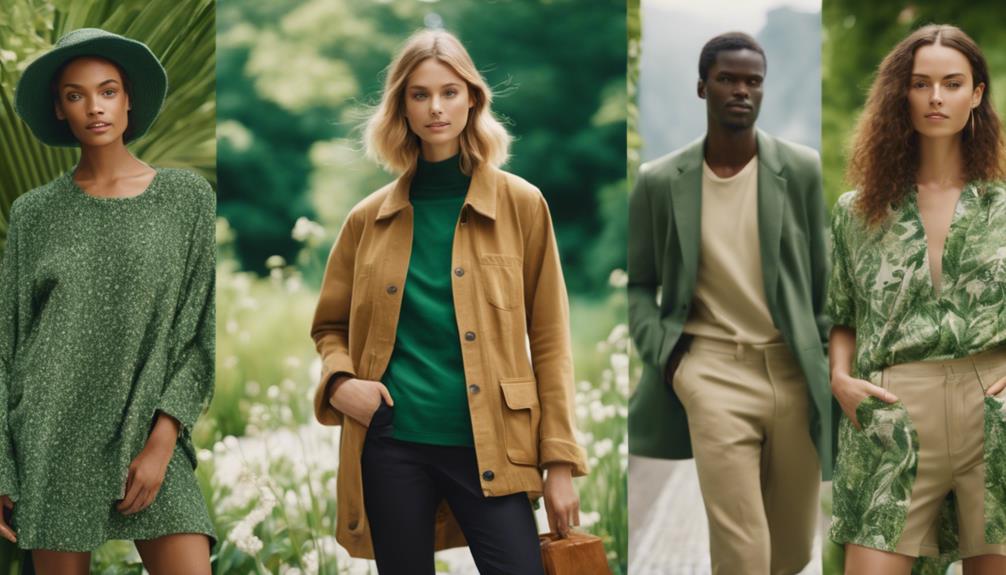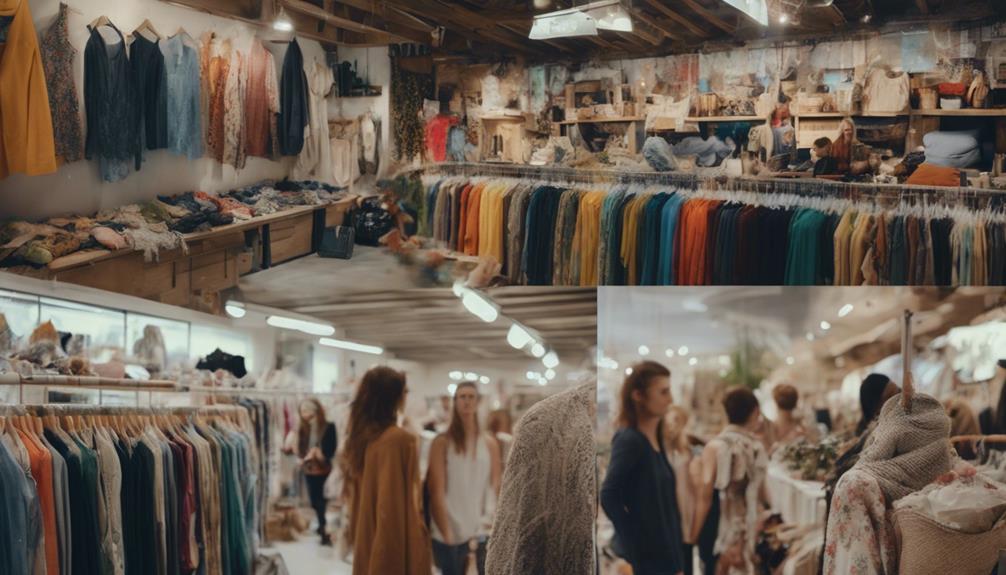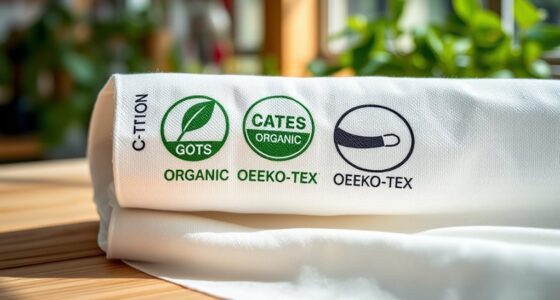Consumers are increasingly interested in sustainable fashion, with 86% considering sustainability to be a crucial goal in the industry. Additionally, 52% prioritize eco-friendly options when shopping. Many consumers, especially Millennials, are willing to pay more for brands that focus on positive change. However, there is a significant level of skepticism, as 88% do not fully trust brands’ sustainability claims, fearing greenwashing. With a shift towards lasting, durable items gaining momentum post-pandemic, it is evident that shoppers are eager for meaningful change. Interested in how these trends could reshape the fashion industry? The following insights may be even more enlightening.
Key Takeaways
- 86% of consumers view sustainability as a vital goal in fashion, indicating strong interest in eco-friendly practices.
- 66% are willing to invest more in brands prioritizing positive change, reflecting a commitment to sustainable choices.
- 88% express skepticism towards brands claiming sustainability, highlighting the need for transparency and trust.
- 71% intend to keep existing items longer, emphasizing a shift towards durability over fast fashion.
Consumer Sentiment on Sustainability
Consumer sentiment on sustainability in fashion is overwhelmingly positive, with 86% of you viewing it as a vital goal. You're increasingly aware of environmental issues related to the fashion industry, such as carbon emissions and water pollution. In fact, 72% of you recognize these challenges and are keen on making a difference through your purchasing behavior.
When it comes to sustainable clothing, 52% of you prioritize sustainability in your clothing choices. Additionally, 55% express interest in opting for sustainable clothing options, showing a strong demand for brands that demonstrate genuine sustainable practices. Millennials, in particular, are leading the way, with 81% prioritizing sustainability in their buying decisions.
However, there's a significant concern about greenwashing. A staggering 88% of you don't immediately trust brands claiming to be sustainable, and 53% find sustainability claims confusing. This highlights the need for clearer communication from brands to build trust with you.
As consumers, your sentiment towards sustainable fashion is strong, but it's important for brands to back their claims with transparent actions to truly resonate with your values.
Importance of Sustainable Choices

Making sustainable choices in fashion not only aligns with your values but also greatly impacts the environment and society. A significant 66% of consumers are willing to invest more in brands that prioritize positive change. This statistic highlights the demand for sustainability among consumers like you, who increasingly seek eco-friendly options. With 52% prioritizing sustainability in their clothing choices, it's clear that there's a strong push for responsible fashion.
As an eco-conscious consumer, you have the power to drive change by supporting sustainable brands that demonstrate social responsibility. Your choices help reduce pollution in the fashion industry, a concern shared by 88% of consumers. By opting for sustainable fashion, you contribute to minimizing the environmental impact associated with traditional clothing production.
However, many of you (48%) are unsure where to find these sustainable brands, indicating a need for better guidance in the market. By seeking out information on sustainable options, you not only fulfill your desire for ethical fashion but also become part of a growing movement that values sustainability and social responsibility. This involvement allows you to make a tangible difference in the world.
Trust and Transparency in Brands
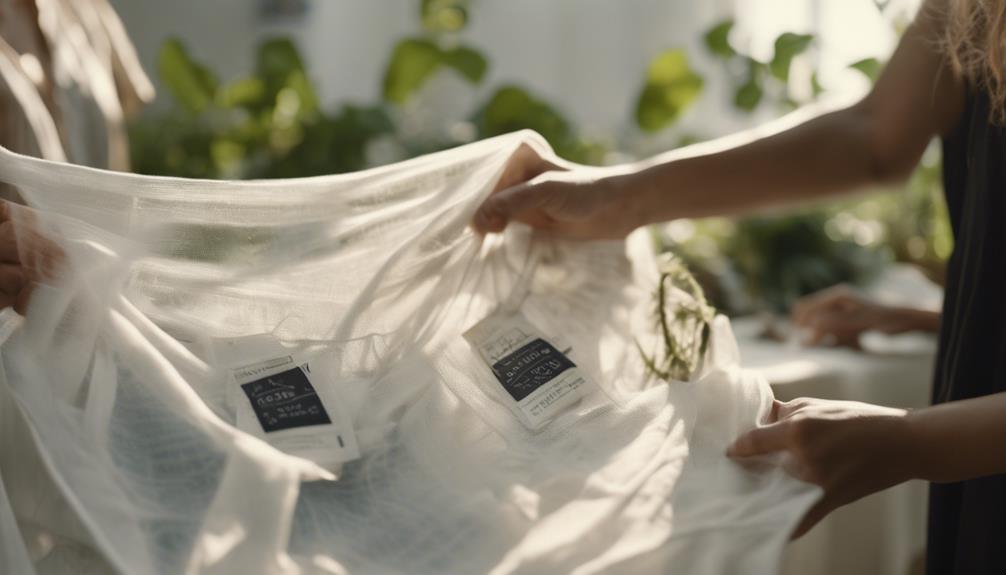
Trust and transparency are vital when it comes to brands claiming sustainability, as many of you are wary of misleading messages in the fashion industry. With 88% of consumers not immediately trusting these claims, skepticism is high.
Here are three key facts that underline your concerns:
- Greenwashing is prevalent: 51% of consumers perceive greenwashing as common, leading to doubt about brands' genuine sustainability efforts.
- Demand for clarity: 55% of you want clearer information about sustainability to make informed purchasing decisions.
- Sustainability labels matter: 50% believe that a sustainability label would help identify truly sustainable clothing options.
These findings highlight the important role that trust and transparency play for consumers when engaging with sustainable brands. If you're unsure about a brand's commitment to sustainability, it can impact your purchasing decisions considerably.
In addition, 44% of consumers feel brands are at fault for not providing enough sustainable options, which only deepens distrust. As you navigate the fashion landscape, look for brands that prioritize transparency and offer clear sustainability labels to help guide your choices.
Impact of COVID-19 on Fashion
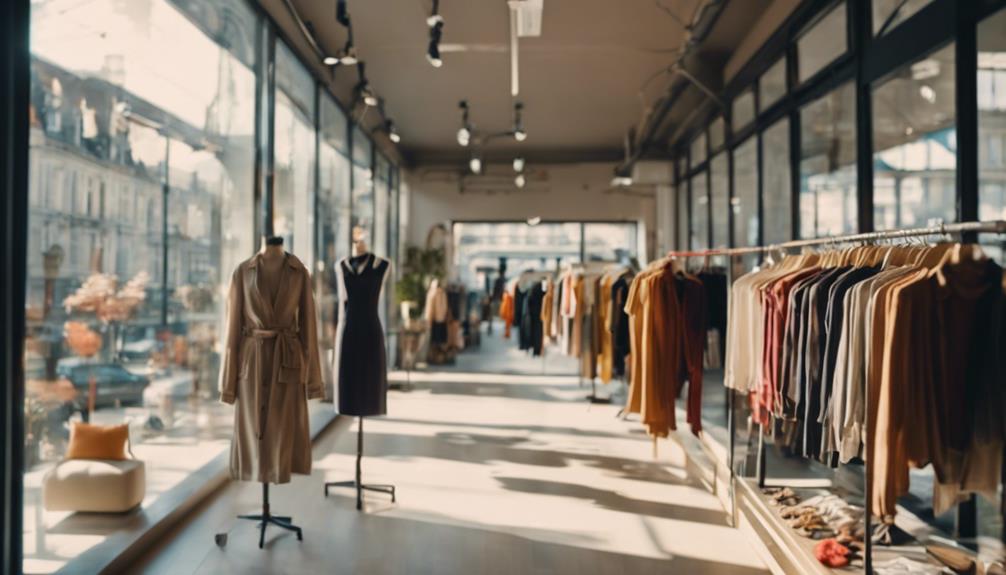
The COVID-19 pandemic has shifted how you think about fashion and consumption.
With many consumers now prioritizing sustainability, you might find yourself purchasing less and opting for secondhand options.
This change in behavior signals a growing awareness of the importance of durability over fast fashion.
Purchasing Behavior Changes
Many consumers have redefined their purchasing habits in response to the economic challenges posed by COVID-19, with over 60% reporting reduced spending on fashion. This shift in purchasing behavior signals a notable change in consumer demand, especially among younger demographics.
Here are three key trends to reflect upon:
- Reduced Spending: Approximately 50% of you expect to continue spending less on clothing, even after the crisis passes.
- Online Shopping: The crisis has accelerated 43% of new online shoppers, with many planning to shop less in physical stores.
- Affordable Products: Younger consumers, particularly Gen Z and millennials, are gravitating towards cheaper products instead of fast fashion, as economic uncertainty shapes their choices.
As you navigate these changes, it's clear that consumers care about sustainable practices and environmental sustainability. Many are now more mindful of the products they choose, leaning towards brands that align with their values.
Social media plays a significant role in influencing these decisions, as you seek out brands that prioritize sustainable fashion. Ultimately, your purchasing behavior reflects a desire for more responsible consumption amidst evolving circumstances.
Increased Sustainability Awareness
Heightened awareness of sustainability issues in fashion has emerged as a significant trend among consumers during and after COVID-19. As you navigate this changing landscape, you'll notice that more consumers say they're concerned about environmental issues and climate change. This increased sustainability awareness translates into shifts in consumer spending habits, with many prioritizing sustainable materials when buying products.
Here's a snapshot of current consumer attitudes towards sustainability in fashion:
| Percentage | Consumer Attitude | Key Insights |
|---|---|---|
| 38% | Heightened awareness of sustainability | Increased engagement in sustainability topics |
| 66% | Prioritizing climate change limits | Focus on environmental impacts |
| 60% | Recycling and eco-friendly packaging | Shift towards sustainable habits |
| 65% | Support for delaying new launches | Preference for sustainability over rapid cycles |
| 71% | Intent to keep existing items longer | Valuing durability and sustainability |
This shift towards a circular economy reflects a growing commitment to sustainability, showcasing how the pandemic has reshaped consumer values. Embracing these changes can help you make more informed choices in your fashion journey.
Shifts in Purchasing Behavior

You've likely noticed a change in how people approach fashion spending lately.
With economic uncertainty, many are prioritizing durability and sustainability over fast fashion.
This shift in purchasing behavior reflects a growing awareness of the long-term impact of our choices.
Economic Impact on Spending
The pandemic has reshaped how consumers approach fashion spending, with over 60% reporting reduced expenditures. This shift reflects a growing awareness of economic realities and environmental responsibility, profoundly impacting the fashion industry.
Here are three key insights into this trend:
- Ongoing Reductions: Approximately 50% of consumers expect to continue spending less on clothing, indicating a long-term change in purchasing behavior.
- Demographic Shifts: Younger consumers, particularly Gen Z and millennials, are increasingly drawn to cheaper products, suggesting a re-evaluation of values in fashion purchases.
- Economic Outlook: With 88% of consumers anticipating a slow economic recovery, concerns about spending habits are on the rise.
As consumers prioritize sustainability, 65% support delaying new collection launches, steering away from fast fashion. This focus on sustainable options signals a shift in consumer behavior that may redefine clothing expenditures moving forward.
In a post-pandemic world, it's clear that economic factors are driving a new era of conscious spending. Understanding these changes can help brands adapt to meet evolving consumer expectations while promoting sustainable practices within the fashion industry.
Preference for Durable Fashion
Consumers are increasingly prioritizing durability in their fashion choices, reflecting a significant shift toward valuing long-lasting items over fleeting trends. Recent data shows that 65% of you plan to buy more durable items post-crisis, highlighting a commitment to sustainable products. Meanwhile, 71% of shoppers intend to keep their existing items longer, demonstrating a growing preference for sustainability and reduced consumption.
Younger consumers are leading the way, with about 50% of them keen on purchasing secondhand fashion, which aligns perfectly with circular business models. This trend not only promotes reusing and recycling clothing but also supports environmental causes that matter to many of you. Notably, newness ranks as the least important attribute in your purchasing decisions, as 58% prioritize factors other than fashion trends.
As over 60% of consumers report spending less on fashion, it's clear that you're adopting a more cautious approach. By focusing on durable items, you contribute to reducing carbon emissions and support clothing brands committed to sustainability. Your choices are shaping the future of the fashion industry, encouraging businesses to embrace this shift towards longevity and responsible consumption.
Opportunities for Industry Transformation

A unique opportunity has emerged for the fashion industry to transform by prioritizing sustainability and responding to shifting consumer values. As you navigate this changing landscape, consider the following key areas for growth:
- Embrace Circular Business Models: Adopt practices that focus on recycling and reusing materials to minimize waste and promote environmentally conscious fashion.
- Invest in Fair Trade Practices: Guarantee that your supply chain supports social and environmental responsibility, enhancing brand loyalty among consumers who prioritize ethical purchasing.
- Focus on Durability and Longevity: Cater to the increasing consumer desire for durable products, as 65% are looking to purchase items that last longer, steering away from fast fashion.
Demographics of Sustainable Shoppers

Sustainable shoppers are increasingly diverse, with young and middle-aged men showing a strong preference for eco-friendly fashion choices. This shift is reshaping the demographics of consumers who prioritize sustainable fashion. Notably, 75% of Gen Z consumers are turning to pre-owned clothes, reflecting a commitment to minimizing their consumption and reducing environmental impact.
While women under 35 remain a significant target for fast fashion brands, millennials are stepping up and are often willing to pay more for sustainable clothing options. This willingness indicates a growing recognition of the value of eco-friendly practices in fashion.
Furthermore, 73% of British consumers who buy sustainable clothing also engage in purchasing second-hand items, showcasing a broader trend towards circular fashion. The influence of social media can't be overlooked; 54% of consumers credit these platforms for shaping their fashion choices, emphasizing the importance for sustainable brands to harness this tool for awareness and outreach.
As the landscape of fashion evolves, it's clear that the demographics of sustainable shoppers are shifting, and brands must adapt to meet their needs.
Frequently Asked Questions
Do Consumers Want Sustainable Fashion?
You might find that a significant number of consumers are increasingly aware of sustainability in fashion. Many express interest in buying eco-friendly options, prioritizing brands that demonstrate sustainable practices and acknowledging the environmental impact of their choices.
Do Consumers Want to Be Sustainable?
In a world where eco-consciousness reigns like a modern-day renaissance, you're increasingly aware of your choices. You want sustainability, and you're ready to support brands that prioritize the planet in their practices.
What Is the Consumer Sentiment on Sustainable Fashion?
Consumer sentiment on sustainable fashion shows strong awareness and interest. You see that many people support eco-friendly practices, yet they struggle to find accessible options. Your choices can drive demand for more sustainable brands.
Why Do People Prefer Sustainable Fashion?
You prefer sustainable fashion because it aligns with your values, reduces environmental impact, and promotes ethical practices. By choosing eco-friendly options, you contribute to a healthier planet while enjoying stylish, durable clothing that lasts.
Are the Findings About Consumer Interest in Sustainable Fashion Really Shocking?
The recent findings about consumers and sustainable fashion are indeed shocking. In a world where fast fashion has dominated the market for so long, it is surprising to see the growing interest in sustainable and ethical fashion choices. This shift signifies a positive change in consumer behavior and priorities.
Conclusion
As you navigate the fashion landscape, think of it like choosing a path in a forest. You can take the well-trodden route or forge a new trail toward sustainability.
A recent survey revealed that 66% of consumers are willing to pay more for eco-friendly products, showing a clear desire for change.
By opting for sustainable fashion, you're not just making a purchase; you're planting seeds for a greener future, one choice at a time.
